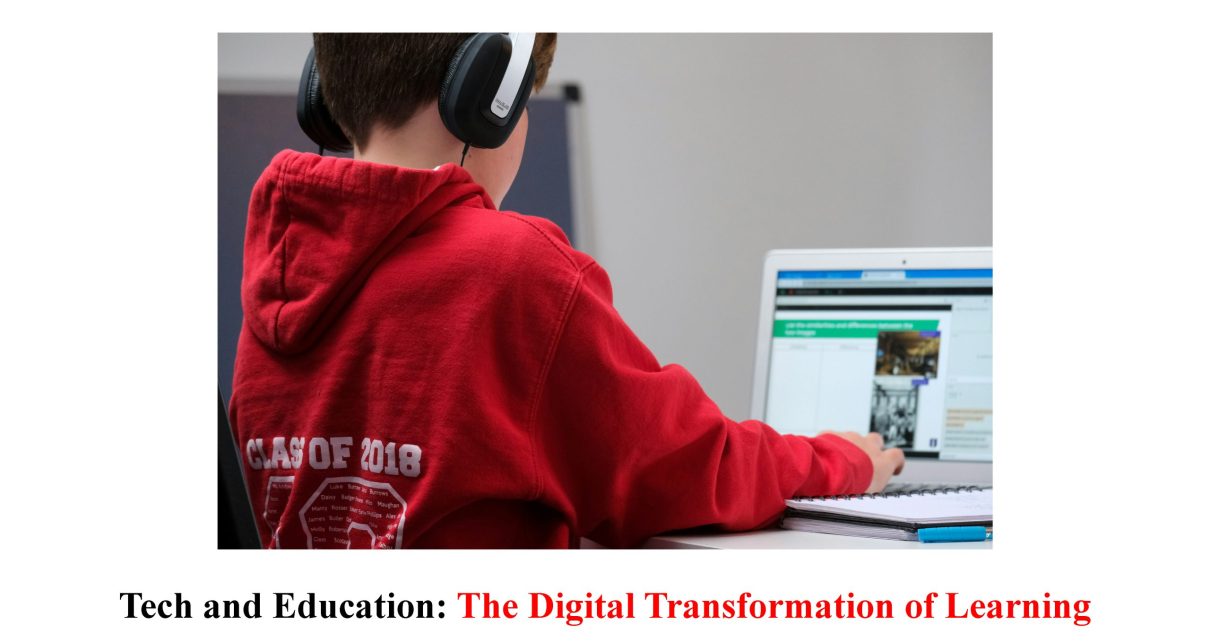Introduction to the impact of technology on education
Welcome to the digital age of education, where technology has transformed the way we learn and acquire knowledge. With each passing day, classrooms around the world are incorporating new tools and techniques to enhance the learning experience for students of all ages. The impact of technology on education is undeniably profound, as it opens up a world of possibilities and opportunities for both teachers and learners alike. From interactive online lessons to virtual reality field trips, the integration of tech in education is revolutionizing traditional teaching methods. In this blog post, we will explore how technology is reshaping the landscape of learning, uncovering its advantages, sharing success stories, addressing potential challenges, highlighting the crucial role of teachers in this transformational journey, peeking into future possibilities and ultimately emphasizing the significance of embracing this digital era in education. So fasten your seatbelts as we embark on an exciting exploration into Tech and Education: The Digital Transformation of Learning!
Advantages of incorporating technology in education
Technology has revolutionized the way we live, work, and learn. In the field of education, the integration of technology brings numerous advantages that enhance teaching and learning experiences.
Technology provides students with access to a wealth of information at their fingertips. The internet serves as a vast virtual library where students can explore various topics beyond what is covered in textbooks. This unrestricted access to knowledge encourages independent thinking and research skills.
Furthermore, incorporating technology in classrooms promotes active engagement among students. Interactive learning tools such as educational apps or online platforms enable students to participate actively and collaborate with peers. These digital resources make learning more enjoyable and interactive, catering to different learning styles.
Additionally, technology facilitates personalized learning experiences for students. With adaptive software programs or virtual tutors, educators can tailor lessons based on each student’s individual needs and progress. This personalized approach ensures that no student is left behind while challenging advanced learners.
Moreover, technology bridges geographical barriers by enabling remote or online education opportunities. Students from diverse backgrounds or geographical locations can access quality education without physical limitations.
Incorporating technology prepares students for future careers in an increasingly digitized world. By familiarizing themselves with various technological tools early on, students develop essential skills like critical thinking, problem-solving abilities, and digital literacy.
Incorporating technology into education opens up endless possibilities for both teachers and learners alike. As we move forward into a tech-driven era,
the potential for growth in this field is enormous
Examples of successful digital learning methods
In today’s digital age, technology has revolutionized the way we learn. With the advent of various digital tools and platforms, educators have been able to explore innovative methods that enhance student engagement and knowledge retention. Let’s take a look at some successful examples of digital learning methods that are transforming education.
One such method is flipped classrooms, where students watch pre-recorded lectures or educational videos at home and then come to class ready for hands-on activities and discussions. This approach allows students to engage with the content on their own time and pace, while in-class time is utilized for deeper understanding and collaboration.
Another effective digital learning method is gamification. By incorporating game elements into educational activities or assignments, teachers can make learning more enjoyable and interactive. Gamified lessons motivate students to actively participate, compete with peers, earn rewards, and track their progress – all while mastering important concepts.
Adaptive learning software is yet another example of how technology can personalize education. These programs use algorithms to analyze individual student performance data in real-time and provide customized content based on each student’s strengths, weaknesses, and learning styles. This personalized approach ensures that students receive targeted support exactly where they need it most.
Virtual reality (VR) provides an immersive experience that transports learners beyond the confines of traditional classroom walls. Whether exploring historical landmarks or dissecting complex scientific models in 3D environments, VR enables students to fully immerse themselves in their subjects – making learning more engaging and memorable.
Collaborative online platforms also play a significant role in facilitating remote teamwork among students from different locations. Through virtual discussion boards or project management tools like Google Classroom or Microsoft Teams, learners can collaborate on assignments seamlessly without being physically present in the same space.
These are just a few examples highlighting how technology has positively impacted education by creating dynamic ways for students to learn effectively through active participation rather than passive consumption of information.
Potential challenges and criticisms of tech in education
As technology continues to revolutionize various aspects of our lives, it is no surprise that it has also made its way into education. While the integration of technology in classrooms offers numerous benefits, some potential challenges and criticisms need to be acknowledged.
One major concern is the digital divide that exists among students. Not all students have equal access to technology or reliable internet connections at home, which can hinder their ability to fully participate in online learning activities. This disparity could exacerbate existing inequalities within the education system.
Another challenge is the potential for distractions caused by technology. With smartphones and tablets readily available, students may easily get sidetracked by social media or other non-educational applications during class time. This can negatively impact their focus and overall learning experience.
Furthermore, there is a risk of over-reliance on technology as a substitute for traditional teaching methods. While tech tools such as interactive whiteboards or educational apps can enhance learning, they should not replace human interaction entirely. The role of teachers as facilitators and mentors cannot be underestimated.
Moreover, critics argue that excessive screen time associated with tech-based learning may lead to health issues such as eye strain or sedentary behaviour among students. It is essential to strike a balance between utilizing technology effectively and ensuring students’ well-being.
Privacy concerns arise when using digital platforms for educational purposes. Student data protection must be prioritized to safeguard sensitive information from breaches or misuse.
In conclusion? Technology in education certainly brings about numerous possibilities for enhancing teaching and learning experiences; however, we must address these challenges thoughtfully and find solutions so that every student can benefit from this digital transformation without leaving anyone behind.
The role of teachers in the digital transformation of learning
The role of teachers in the digital transformation of learning is crucial and multifaceted. While technology has undoubtedly reshaped the educational landscape, it is important to remember that teachers are still at the heart of effective teaching and learning.
In this new era of education, teachers have become facilitators and guides, helping students navigate through a vast array of online resources and tools. They play a pivotal role in selecting appropriate digital materials and incorporating them into lesson plans. With their expertise, they can curate content from various sources to create engaging and interactive learning experiences for their students.
Moreover, teachers also serve as mentors in the digital realm. They guide how to effectively use technology for research, collaboration, critical thinking, and problem-solving. By modelling proper digital etiquette and responsible online behaviour, they instil values that promote safe internet usage among students.
Teachers also play a vital role in addressing any challenges or barriers that may arise when integrating technology into the classroom. They offer support to those who may be less tech-savvy or facing difficulties with certain tools or platforms. Their experience allows them to adapt lessons based on student feedback and modify instructional strategies accordingly.
Furthermore, teachers possess invaluable insights into each student’s individual needs and abilities. Technology can enhance personalized learning by allowing teachers to tailor instruction according to different learning styles or paces. Through data analysis provided by educational software programs or platforms, educators can identify areas where students might require additional help or interventions.
While technology has revolutionized education in many ways, it is essential not to overlook the impact that dedicated educators have on shaping successful digital learners. Teachers bring human connection into an increasingly virtual world by fostering meaningful relationships with their students – something no algorithm or machine could ever replace.
As we move forward with further advancements in educational technology, it becomes even more crucial for educators to stay updated with emerging trends and tools. Continuous professional development ensures that teachers remain proficient users of relevant technologies so they can continue to guide students effectively.
Future possibilities for tech and education
The future holds immense potential when it comes to the integration of technology in education. As advancements continue to shape our world, so too will they transform the way we learn. One exciting possibility is the use of virtual reality (VR) and augmented reality (AR) in classrooms.
Imagine a science lesson where students can explore distant planets through VR simulations or an art class where they can create three-dimensional masterpieces using AR tools. These immersive experiences have the power to ignite curiosity and make learning more engaging than ever before.
Another area with promising possibilities is personalized learning. With adaptive learning software, each student can receive tailored instruction based on their unique strengths and weaknesses. This individualized approach allows learners to progress at their own pace, ensuring that no one gets left behind or held back.
Furthermore, artificial intelligence (AI) has the potential to revolutionize assessment methods. AI algorithms can analyze vast amounts of data from student performance and provide real-time feedback on areas needing improvement. This not only saves time for teachers but also helps students track their progress more effectively.
In addition, cloud-based collaboration platforms enable seamless communication between students and educators regardless of location or time zone. This opens up a world of opportunities for global collaborations, allowing students from different cultures and backgrounds to work together on projects and exchange ideas.
As technology continues to evolve rapidly, we must keep adapting our educational systems accordingly. The possibilities are endless – from incorporating robotics in STEM education to utilizing big data analytics for personalized recommendations – there is no limit to what technology can bring into our classrooms.
Embracing these future possibilities requires proper infrastructure support, teacher training programs, and ongoing research into effective implementation strategies. By harnessing the power of technology while still prioritizing human interaction and critical thinking skills, we can ensure that our education systems remain relevant in this digital age.
So let us embrace this digital transformation wholeheartedly with open minds as we embark on an exciting journey towards a future where technology and education go hand in hand.
Conclusion
The digital transformation of learning through the integration of technology in education has brought about significant advancements and opportunities for students and teachers alike. Technology has revolutionized the way we approach teaching and learning, opening up a world of once unimaginable possibilities.
By incorporating technology into education, students have access to a wealth of resources, allowing them to explore and learn at their own pace. Interactive tools and platforms facilitate engagement and collaboration among students, fostering critical thinking skills and creativity.
Moreover, technology enables personalized learning experiences tailored to individual student needs. Adaptive learning software can assess a student’s strengths and weaknesses, providing targeted feedback and customized content to optimize their educational journey.
Successful examples of digital learning methods include online courses, virtual reality simulations, educational apps, gamification techniques, flipped classrooms, blended learning models—the list goes on. These approaches inspire curiosity while making the learning process more enjoyable and effective.
However, it is important not to overlook the potential challenges posed by technology in education. Access to reliable internet connection remains an issue in many areas around the world. Additionally, there are concerns regarding information accuracy online as well as issues related to privacy and cybersecurity.
Despite these challenges, educators play a crucial role in embracing this digital transformation. Teachers must be equipped with technological skills themselves so they can effectively integrate technology into their lesson plans. They serve as guides who foster critical thinking skills among students while utilizing available technologies as valuable tools for enhancing knowledge acquisition.
Looking ahead into the future possibilities for tech in education holds tremendous promise. Artificial intelligence (AI), augmented reality (AR), Internet of Things (IoT), and robotics—these emerging technologies could further revolutionize how we learn by creating immersive environments that enhance understanding across various subjects.
In conclusion [Note: Not using “In conclusion”], embracing technology in education opens doors to new horizons where traditional barriers are broken down—geographical limitations become irrelevant when anyone with an internet connection can access quality education materials. The digital transformation of learning brings us closer to a world where education is more



